Drones over the trenches: countering reconnaissance quadrocopters and adjustments on the front line

The Russian Special Military Operation (SVO) in Ukraine has become the largest military conflict in the last half century and the largest military conflict on the European continent since World War II. We can say that even the participants are the same, only now the USA, Canada and Great Britain have joined the Nazi bloc.
Another distinctive feature of this war was the use of the latest means of reconnaissance, communications and information processing, which had never before been used in such quantities and so intensively. It is they who determine the format of hostilities that the NWO eventually came to, namely, artillery warfare with slow “gnawing through” enemy positions by infantry units reinforced with armored vehicles - no tank wedges and "blitzkriegs".
If striking with precision weapons into the depths of the enemy’s territory is mainly based on satellite and undercover intelligence data, then on the advanced the most important task of detecting the enemy, adjusting the actions of ground units and fire weapons is performed by small-sized unmanned aerial vehicles (UAVs) of a quadrocopter, hexacopter, octacopter, etc. type, as well as aircraft and helicopter schemes. Since most of these UAVs are commercial small-sized UAV quadrocopters, we will talk about them in the future.
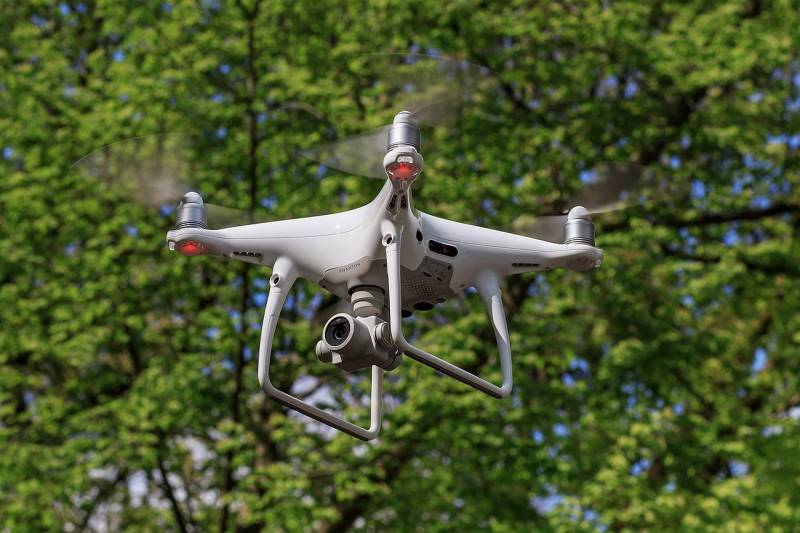
Commercial small-sized UAV quadrocopters have become one of the most important and effective means of tactical reconnaissance during the NWO
It is necessary to recall the importance of flashing civilian dronesused by our armed forces during the JMD, and as an argument, cite an excerpt from one of the Ukrainian documents published on the Lobaev Z telegram channel:
We propose the following measures to counter UAV groups of the RF Armed Forces:
Widespread use of an aeroscope to locate the location of the drone operator. The enemy (that is, we are Russians) due to the low level of preparation for modern warfare of a significant part of the officers of art. and senior management, practically does not spend time on specials. firmware and hardware-type anti-detection systems, like those offered by the war criminal V. E. Lobaev and his factory (thanks for the praise, I'm always glad. - Note Lobaeva). So the aeroscope captures everything easily. Where airscopes are available in the right number, and the Russians are operating unwired drones, their operator’s work time is calculated in ten minutes before the artillery is covered. fire. After that, the operator either runs away, or gets injured, or dies, leaving the units without visibility and quick coordination. Attention for mortar crews, guns and snipers - the UAV operator is YOUR KEY GOAL!!! There are few of them qualified, and the loss of each is sensitive!!! To learn something new, the same efficiency, you need to spend a lot of time and effort. And it's not easy to find a suitable person for this position! In the light of what we remember - the destruction of spotters, as well as communication repeaters, are key priorities!
On the Internet, there is a huge number of videos taken from UAVs that detect enemy manpower and equipment, provide adjustments to the fire being fired at them, as well as direct dropping of small-sized mines and grenades, carried out with the help of special devices.
There is no doubt that small-sized quadcopter UAVs are a significant threat to our soldiers on the front lines, which means that their destruction is one of the highest priorities.
To destroy UAV quadrocopters, it is necessary to provide:
- primary detection of an enemy UAV quadrocopter over the battlefield;
- additional search, escort and precise aiming of weapons at him;
- defeat by one or another type of weapon.
Let's consider these tasks in more detail.
Detection
The task of detecting UAV quadrocopters is one of the most difficult. These drones are small in size, their bodies are mostly made of plastic. Because of this, they are poorly distinguished by radar stations (RLS) of anti-aircraft missile systems (SAM). In addition, the operation of the radar is detected by the enemy’s electronic intelligence (RTR) means, after which an anti-radar missile (PRR) of the AGM-88 HARM type, a HIMARS multiple launch rocket system (MLRS) guided missile or other guided or unguided munitions can fly into it.
They are also practically invisible in the thermal imager, since the operation of the electric motors is powered by batteries, and they practically do not emit heat - of course, we are talking only about electric quadcopters, and not about agricultural UAVs with gasoline engines, rattling like a lawn mower and glowing in infrared (IR) range like a Christmas tree.
Also, electric UAV quadrocopters practically do not make noise. From personal experience, the DJI Mavic Mini drone “buzzing” on the ground quite loudly at an altitude of 300-500 meters becomes barely audible, and this is in the forest, almost in absolute silence, what can we say about the battlefield. At the same height, it becomes barely visible visually - it can be detected only if you know for sure that it should be there.
Then how to carry out the detection of UAV quadrocopters?
It can be assumed that RTR means can and should be used in the first place. The fact is that any UAV quadrocopter has a permanent communication channel with the operator that controls this UAV. This channel lies in the range from 900 MHz to 5,8 GHz.
You can detect the radiation of UAV transceivers using SDR (Software Defined Radio) receivers and spectrum analyzers with advanced functionality - we already talked about their use earlier in the material The hunt for Starlink terminals and their operators is declared open. Compared to radar and thermal imagers, this equipment costs mere pennies. Even with the help of a single SDR receiver or a spectrum analyzer, in combination with a directional antenna, it is possible to determine the approximate direction to the desired UAV, for example, on the Golden Hands of an Angel telegram channel, a method for detecting drones using the Arinst spectrum analyzer was shown. It can be assumed that a distributed system with triangulation of the signal source will make it possible to do this faster and more accurately.
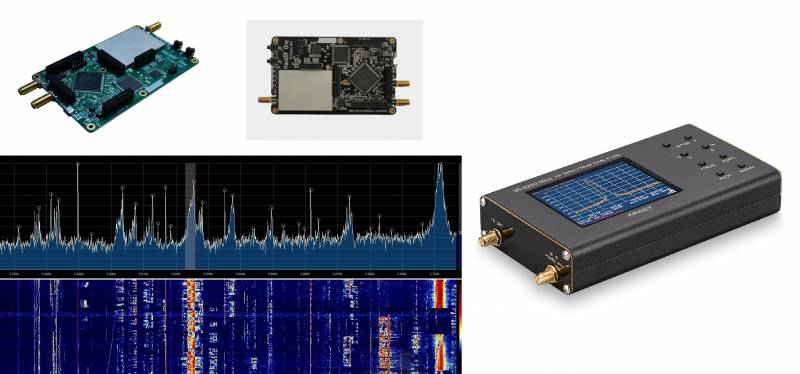
HackRF SDR receiver with a scanning range from 1 MHz to 6 GHz (left) and an Arinst spectrum analyzer with a scanning range from 35 MHz to 6,2 GHz (right)
The second possible method for the primary detection of enemy UAV quadrocopters is acoustic. As mentioned above, the DJI Mavic Mini electric UAV becomes barely audible at an altitude of 300-500 meters, that is, some sound amplification devices are needed to detect such UAVs. Enterprises of the Rostec State Corporation have created the Attack-Shoroh acoustic reconnaissance module, the exact characteristics of which are unknown.

Acoustic reconnaissance module "Ataka-Shorokh"
Other similar systems can be developed, even by civilian companies that are not currently working in the ranks of enterprises of the military-industrial complex (MIC) - some enterprises have a certain interest, as well as the necessary competencies, but they are not ready to work in this direction without a specific customer . In the end, the first direction finders were created during the First World War.
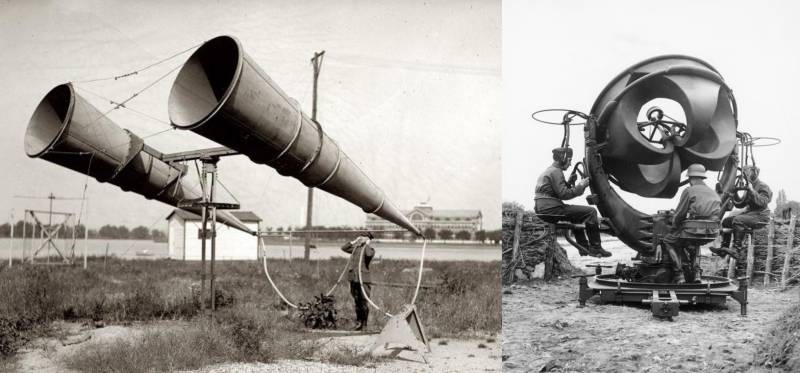
Sound pickups-direction finders of the times of the First (left) and Second (right) World Wars
Of course, modern means of acoustic reconnaissance should not be as large as during the First and Second World Wars. Presumably, they can be made on the basis of modern hearing aids with a cutoff for exceeding the sound threshold.
Acoustic means of detecting UAVs can include both all-round visibility systems and systems designed to more accurately determine the direction of an enemy UAV quadrocopter. In the simplest version, the UAV can be detected by the operator by ear. In more complex systems, the acoustic signal can be converted to a digital format for analysis, the spaced acoustic receivers will allow you to determine the direction of the enemy UAV. "Acoustic portraits" of the most famous UAVs can be compiled to determine their type.
The proposed electronic reconnaissance equipment based on SDR receivers and spectrum analyzers with extended functionality, as well as acoustic detection equipment, are completely passive systems, that is, they do not emit anything and cannot be located by the enemy to strike with artillery or aviation.
Escort
After the enemy UAV quadrocopter is detected and the approximate direction to it is determined, it is necessary to carry out an additional search for its exact location and escort for subsequent defeat. It is extremely difficult to visually detect a UAV quadrocopter located above 300-500 meters, so some kind of sighting devices are needed.
To detect UAV quadrocopters in the daytime, according to preliminary target designation from detection tools, an optical sight may be sufficient, the magnification of which and the width of the field of view can only be determined empirically. As an alternative, the use of professional video cameras with a variable magnification of the lens and displaying the image on a high-resolution display can be considered.
There is one problem in terms of optical sights and high-resolution daytime television cameras - with their help it is difficult, rather impossible, to detect a quadrocopter UAV at dusk or at night.
The simplest solution, again, based on the experience of the Second World War, is the use of active illumination in the visible range in combination with the aforementioned optical sight. As an optical illumination in the visible wavelength range, the use of LEP-lamps (not to be confused with LED - LED lamps) can be considered. This type of light sources is based on the use of a laser to excite a small dot of a phosphor with a laser, which makes it possible to obtain a narrow long-range beam - the range of illumination by the beam of a LEP flashlight can reach several kilometers.

LEP flashlight beam
Additionally, illumination with a small-sized diode laser with a power of about 1,5 W at a wavelength of 405 nm can be applied to them (available market solutions). A laser with such a wavelength causes the fluorescence of many materials, with a high probability the white parts of a UAV quadcopter will be very clearly visible at a great distance (think of glowing white T-shirts in discos).
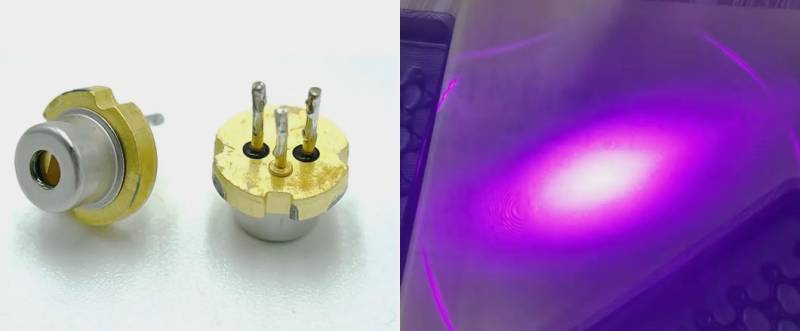
Laser diode with a power of more than 1 W at a wavelength of 405 nm
Another solution could be the use of night vision devices/sights (NVD). Not thermal imagers, since UAV quadrocopters are poorly distinguishable in them, namely night vision devices based on the amplification of visible light and infrared radiation of the near range (the author has no personal experience of observing UAV quadrocopters in a thermal imager, in theory, electric UAVs should also radiate heat, the problem rather, the fact that thermal imagers that can see it at a great distance are very expensive).
In turn, night vision devices are divided into analog ones, made on the basis of electron-optical converters (IOC), whose work is based on the principle of light amplification, and digital ones, equipped with a highly sensitive matrix capable of operating in the near-IR range. Digital night vision devices/scopes may have zoom lenses and display the image.
It can be assumed that in the passive mode, only the most modern, rare and expensive analog night vision devices of the third generation will be able to detect UAV quadrocopters. Thus, with a high probability, it will be necessary to use IR illumination, for example, based on the same laser diodes, only in the IR spectrum, which are very widespread and have high radiation power and efficiency. And if you can’t do without illumination, then it makes no sense to use expensive analog night vision devices, when digital night vision devices in combination with laser IR illumination can cope with this task of additional search and tracking of UAV quadrocopters at night.

Image from a digital night vision scope
All proposed measures can be used both individually and in combination. For example, if it is not possible to destroy enemy UAVs at night, then having cleared the sky from them during the day, it is possible to regroup during daylight hours, take out the wounded, and bring supplies.
It is advisable to complete the means of additional search and tracking with a laser rangefinder - they are quite inexpensive and will allow you to more accurately defeat drones.
A variant of a kind of “sniper pair” can also be considered, when, in addition to the means of additional search and tracking of UAVs placed in service, the “second number” will have its own set of additional search and tracking tools, supplemented by a laser target designator based on a laser diode with a power of 1-1,5 W with a wavelength of 520/525 nm. The advantage of such a laser designator is that its beam is visible even during the day in cloudy weather, that is, the “second number” can quickly and effectively indicate the direction of the UAV to the “first number”.
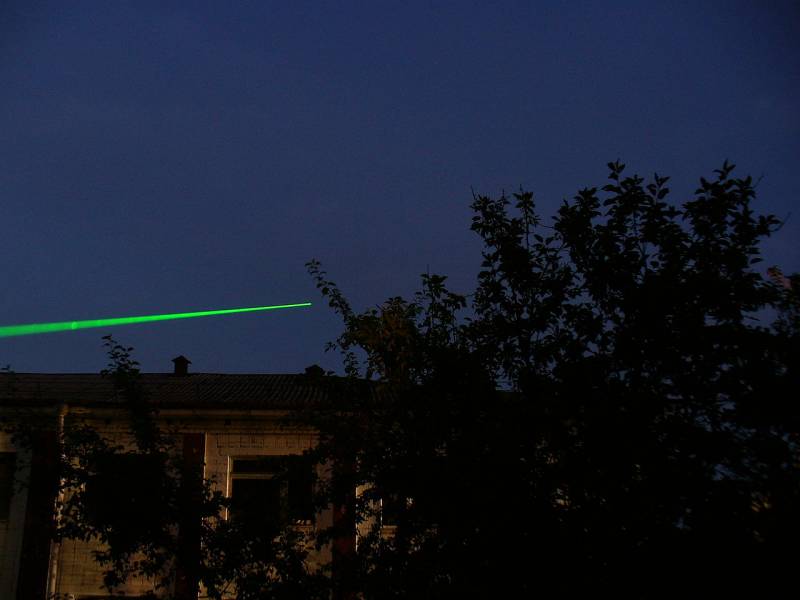
A powerful green laser will allow you to give target designation to the UAV quadrocopter not only at night, but also during the day in cloudy weather (in clear weather, the drone will be easier to detect anyway) - you need a visible beam, since it will be difficult to point and hold a point directly on the UAV
Of course, the use of active emitters - LEP flashlights, IR lasers, lasers with a wavelength of 405 nm, and especially 520/525 nm, can unmask the position of the shooter / observer, but from afar you can only determine the direction to the light source - it is extremely difficult to determine the distance to it difficult, and near the UAV-quadcopter of the enemy, especially if he has a thermal imager, and so will ensure the detection of our fighters by the enemy. It is better to find yourself, quickly destroy the enemy’s UAV-quadcopter and change position than to quietly wait for an artillery raid according to its target designation.
Defeat
Since we are talking about the fight against drones on the front line, the range of destruction will be limited to about one kilometer. Two options can be considered - portable and transportable. Accordingly, in the first variant, the mass, dimensions and recoil of weapons of destruction will be limited.
Presumably, 7,62x54R caliber machine guns, for example, PKM or Pecheneg, equipped with means of additional search and tracking of UAVs, discussed in the previous chapter, can act as means of fire destruction. Machine guns should be mounted on a portable turret, which ensures the convenience of their use on air targets. Defeating a small target at a distance of about one kilometer is a rather difficult task, so it is possible that the accuracy and accuracy of machine guns will not be enough.
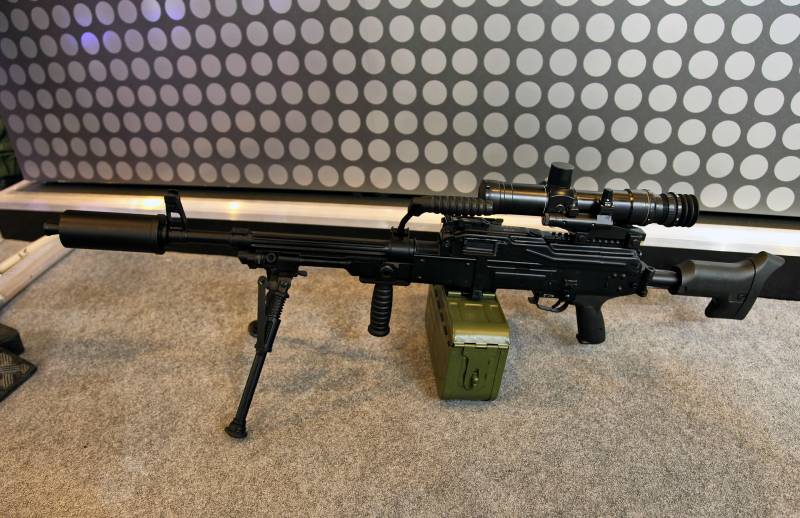
Pecheneg-SP machine gun with optical sight and tactical silencer
As an alternative, you can consider the use of high-precision semi-automatic sniper rifles, for example, the "Counter" model of caliber 7,62x51 mm from Lobaev Arms. The rifle should also be located on the turret. It is possible that in order to destroy air targets, the "Counter" should be supplemented with a mode of fire in short bursts (2-3 rounds each).

Sniper rifle "Counter"
It would be interesting to test the effectiveness of the AN-94 assault rifles against small UAVs in the mode of firing in short bursts of two rounds with a rate of fire of 1800 rounds per minute, although, of course, the range of destruction with a cartridge of 5,45x39 mm will be significantly less than with a cartridge of 7,62x51 mm or 7,62 ,54xXNUMXR.
Ultimately, the choice of the optimal weapon variant can only be made based on the results of practical tests.
Separately, it must be said about ammunition. Airsoft sometimes uses ultraviolet (UV) lights to fluoresce flying balls to improve the player's shooting accuracy. Presumably, a fluorescent composition can also be applied to the bottom of the bullets of 7,62x51 mm and 7,62x54R cartridges. In combination with the aforementioned 405 nm laser, this will allow the shooter (and the second crew number) to visually observe the trajectory of the bullets flying towards the attacked UAV for effective shooting adjustment. However, here the involvement of cartridge factories will already be required, which will obviously not be easy. Is it possible to ensure the manufacture of such "anti-drone" cartridges in small batches at small enterprises ...
In the portable version, heavy machine guns NSV, "Kord" chambered for 12,7x108 mm or automatic guns ZU-23-2 chambered for 23x158 mm ammunition, placed in the bodies of pickups or trucks, can act as means of destruction. As in the case of wearable complexes, the optimal choice can only be made based on the results of practical tests. Quadcopter UAVs are a small and difficult target to hit, weapons to destroy it must have high accuracy and accuracy of fire.
You can also consider such rather exotic weapons as the YakB-12,7 four-barreled machine guns chambered for 12,7x108 mm and GShG-7,62 chambered for 7,62x54R. The YakB machine gun is installed on some modifications of the Mi-24 transport and combat helicopter, and the GSHG machine gun is used in the suspended gondolas of the Ka-29 helicopter along with the above-mentioned YakB machine gun.

Machine guns YakB-12,7 (left) and GShG-7,62 (right)
The Belarusians installed two GShG machine guns on the Berserk robotic system, which is designed to support ground forces and, according to some reports, to destroy UAVs.

Belarusian robotic complex "Berserk" with two machine guns GShG-7,62
To aim and hold large-caliber and high-speed machine guns during firing, massive machine guns placed in car bodies will be required.
Conclusions
As we said at the beginning, the fight against enemy UAVs that carry out tactical reconnaissance at the forefront, adjust artillery fire and drop grenades / mines on the positions of our fighters is one of the priority tasks. This material discusses the means to ensure the primary detection, additional search, tracking and destruction of enemy UAVs.
In essence, the proposed solutions represent a spatially and functionally distributed anti-drone complex, each of the components of which can function independently or in combination, complementing each other's capabilities.
Let's list the elements that can be included in it.
Detection:
- means of electronic intelligence based on SDR receivers;
- means of electronic intelligence based on spectrum analyzers;
- acoustic means of reconnaissance.
Additional search and support:
- optical sights;
- high-resolution daytime video cameras with lenses with variable magnification;
- LEP lights;
- lasers with a wavelength of 405 nm, power over 1 W;
- digital night vision devices with laser infrared illumination;
- green lasers with a wavelength of 520/525 nm, power over 1 W (target designation).
Defeat (wearable variants):
- machine guns of the PKM or Pecheneg type chambered for 7,62x54R;
- semi-automatic high-precision rifles of the "Counter" type, caliber 7,62x51 mm, possibly supplemented by a fire mode with short bursts of 2-3 shots.
Defeat (portable options):
- machine guns NSV or "Kord" caliber 12,7 mm;
- automatic guns ZU-23-2;
- YakB rapid-fire machine guns chambered for 12,7x108 mm and GSHG chambered for 7,62x54R.
For the operation of all the above elements of the complex, you will need:
- operators of reconnaissance equipment;
- arrows (first number);
- observers (second number).
The number of reconnaissance assets, shooters and observers per kilometer of front will be determined by the characteristics of the equipment for detecting, additional search and tracking drones, as well as the effectiveness of the selected means of destroying enemy drones. In the future, we will try to consider other ways to defeat enemy UAVs, in addition to those presented in this material.
Information